|
|
 |
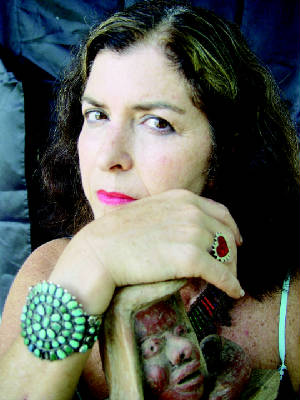
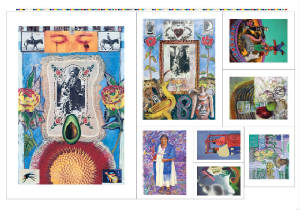
Please look thru the Reviewer pages
to see what Books we have and Information. INTRODUCTION About Anton Haardt
WELCOME My name is Anton Haardt and I’m a Short
Story Writer, Folk Art Gallery owner and full time Artist, and Author of
Mose T From A to Z: TheFolk art of Mose Tolliver,
Published in 2007.
Here is some information about
me. The World of Anton Haardt A native of the Deep
South , I was born in Alabama. I began
painting at the age of eight, going with my Mammy Zora to an old and rickety third floor
studio for classes taught by an aged Mrs. Wilkerson. My uncle was H.L. Mencken, the well known Baltimore critic. My aunt was
Sara Haardt, a writer of southern fiction in the 1930's. Later, I attended Washington University and the San Francisco
Art Institute, where I earned a degree in printmaking in 1971. I grew up dreaming
of being any place but there, and I left as quickly as I could. With time and education I began to gain an
understanding of the complicated realities of the South, and through travel I learned to appreciate my own culture.
.I suppose
my instinct for travel and the unusual that lead me to study the art of
southern self-taught and visionary artists.I developed an ongoing interest in folk art in the early 1970's after I met self-taught painter Mose
Tolliver, who lives near her family home in Montgomery Over the years my love of travel took me to
Mexico City where I lived in the Zona Rosa and attended classes at El Molino. Later I gained admittance to Instituto Allende
and lived for a year in San Miguel De Allende, where I studied many art mediums. In 1982, I opened Anton Haardt Gallery, a
contemporary art gallery in Montgomery Alabama, and in October 2001, I another opened another gallery on Magazine Street in
New Orleans. Both galleries display works by academically trained and self-taught artists from the American South, as well
as traditional art from Latin America. In the early 1970’s I lived in
Mexico and created a novel
titled Santo Negri , based on a true story about a
couple, where one was imprisoned and the other was a
visitor. Both one by choice and one by necessity
spent one year and half in in a 100 year old
French built Mexican Prison until the prisoner escaped through the sewer
pipes. The book was never published and only in 2014 I
re-edited it and offered it for publication as an E-Book.
Like
many, my road to becoming an author wasn't an easy one. I wrote in a variety of genres mostly
travel journal entries from 1971 to 1987. I first
attempted to find a Publisher and Agent for my Mose T A to Z
book in 1992 and after numerous
rejections I did not give up. I
decided to finish my book and other writing
projects I formed my own publishing company Saturno Press in 2005.
I created a beautiful Coffee Table Book Mose
T From A to Z: The Folk Art of Mose Tolliver, in 2007
after many years of work. The Book has won may Awards and received
many favorable Book Reviews. In 1981 I began another Memoir, Run
Toward the Sun: Remembering Juanita Rogers, about another Alabama Folk Artist, Juanita Rogers. I
became a frequent visitor to her home near Montgomery. Over the years I amassed many
hours of audio and video-taped interviews with Juanita Rogers and her rural primitive surroundings, and
photographed her and many of her creations. Folk artist Juanita
Rogers was an uneducated black woman living in a dilapidated shack outside Montgomery, Alabama. She had a powerful creative
talent and mystifying spirit. Juanita’s crumbling sculptures were made of mud, moss and bones: frightening evidence
of compulsion. The haunting figures were part of Juanita’s stories of magic stones, nuns and graveyard dirt. Much defied
logic. I visited her regularly and eventually became her confidant and the mender of her mud creations. I choose not to dismiss
her as crazy but instead to explore the mystery of her creative drive. Our challenging climb to friendship continued till
her death in 1985.The two of us through our struggles transcended our barriers and together united to preserve and further
Juanita's mission. Run Toward the Sun is the celebration of this unique and obstinate artist and my quest to document and elevate
her life’s work. The book
is filled with Photographs and quotes from Rogers . The book also contains one
essay on Juanita Rogers and her work. Folk art scholar, Tom Paterson, has provided an art-historical Introduction.By
way of comparison, Run Toward the Sun: Remembering Juanita Rogers bears thematic
similarities to Los Angeles Times columnist Steve Lopez’ non-fiction book The Soloist,
in which Lopez, a relatively privileged Los Angeles journalist, befriends and assists a mentally ill man who lives homeless
on the Los Angeles streets but turns out to be a musical prodigy and dropout from New York’s Julliard School
of Music I continuously working on a series
of Southern Short Stories based on my life in the deep south of Alabama. Those
stories (written from 1987 - 2011 transcribed from my ubiquitous Journals)
eventually became A Short Story Anthology, Wisteria
Pentimentos:Stories of the South . I
traveled frequently during 1971 until 1987 : to
South America, North Africa, Mexico and parts
of Europe. Photographing my travels and keeping a Sketch
book for many drawings from my travel Journals 1971-1987. These Journals
of vignettes and longer short stories became
my Anthology of Vignettes
tilted Let’s Get Lost: Raquachismo Travel Vignettes
.Both of these Anthologies are now E-Books available through my Website.
Meanwhile life became more difficult. I was unsucessfull
to find an Agent for my Projects, and found I
had less time o devote to my Art and writing. In my personal life
I wanted to have child but infertility halted that
progress. My biological clock was ticking and
we fortunately tried Invitro.With the miraculous birth of my
son Haardt Moes, one of the first 5000 invitro
Babies, I became a mother. Raising my son took
over as big portion of my life to care for him. Being an only
child myself with my mother in her eighties,
I desperately tried to incorporate Family
with my Profession.
To make matters more difficult, I had chosen to live in a primitive
jungle village in Mexico without electricity, rampant with the treacherous
Scorpions and other jungle adversities. In an article on me in Puerto Vallarta
Mexico Banderas News I said: "
My home in Yelapa, Mexico, a primitive fishing village overlooks the sparkling Pacific Ocean. The rolling paths and lush jungles
of Mexico have inspired my art; creating a unique mix of familiar and fantastic, tropical and urban. For most of those years,
I lived with no electricity and painted with only natural light." You can see our Yelapa home at http://www.vrbo.com/298403 Self-publishing in the early years wasn't very profitable, but the number of
Books that I sold grew (along with the popularity of folk art in those
days). Things got better. I continued my quest as a professional Artist
and regularly had Exhibits of my work in America and Europe. I had graduated from San Francisco Art Institute in 1971. I studied printmaking in school and for many years I
have made Lithogrpaphy prints, collages, and paintings. I have photographed places and people
all over the world. Although I have been photographing my
surroundings for many years , I had only taken a few courses in Photography. Many of my photographs
, as well as my paintings have sold at Auction and to prominent collectors. Most recently some of my photographs and
writings of Folk Artists have ben published such as the essay I wrote on Juanita Rogers for Bill Arnett’s Book on Vernacular Southern
Art, Souls Grown Deep. My
work has been displayed imn many galleries and Museums. I was given
a One Person show at The Montgomery Museum of Art and
I have won numerous Competitions such as Los Angeles International
Art Competition. My art work is in prominent collections such as the Tampa Museum
and in the Blount Collection. See More of my Art
work at : . http://antonart.com/moolar/bio.html
My latest Mose
Tolliver Book project : An Interactive Mose T a to Z book In 2012 , I began
working with photographer and video specialist,Gary
St Martin , on an interesting project, a revolution in the accessibility for my Folk
Art book on Mose Tolliver.There has been an obvious rise in the creation of interactive publishing
recently. I had always had a nostalgia about the smell and feel of a paper book, but I've
now gravated toward interactive media,which has given a new very exciting edge for
my folk art book on Mose Tolliver.
Viewing
a book, by adding electronic media is now a contemporary digital reality , and my Mose
T book may be the first interactive book on a Souther Folk Artist, or at least one of the first! My Mose Tolliver book
is now updated with very unique, innovative, interactive experiences that piques curiosity, spurs discovery,
and inspires . It is available for download where each page comes to life. With this interactive
addition, the artwork takes on the shape of an event. We are almost finished with very
technical stages that will bring to life Mose's art work
and will enhance the experience of learning about Mose T's life. It
will provide a sense of steering through his world, with active links to bring my Mose
T book to another dimension (music, audio interviews,videos,slideshows, pop up windows, etc). So what's next?
My book on Mose Tolliver will be available this month through
Gary's EPub site.With the masterful help of Gary St. Martin, Run
Toward the Sun :Remembering Juanita Rogers is
almost completed as an Ipad book. This past year I came up
with the idea of combining my artistic talents with my writing abilities
and turned my short story anthologies into a sort of Collaged
Vignette, each with my
numerous Photographs and Drawings. I’m currently combining
many drawings in a sort
of photo- montgage and hope to make the E-books also available as a
paper publications. After twenty five years, I
continue to live in the same primitive jungle village , which now has electricity.
I spend the rest of my time in our New Orleans home in the stately
old Garden District neighborhood, across the street from the site of the F
Scott Fitzgerald story -made movie Benjamin Buttons and
a block from home of Actress Sandra Bullock. So, that’s a bit about me and what I’m up to from a writing and
personal perspective. If you want to reach me, contact information follows. I
hope to have my creations reviewed by any
Book Reviewers. I’m still open to finding an Agent ,
if the right Agent should come along. I would also enjoy hearing from readers
so don’t be afraid to drop me a line. Thanks for visiting my Publishing site , and I hope you’ll become a follower,when
I get my blog up. I am always curious
if people are interested in what I have to say. Thanks! From Anton HOW TO CONTACT: email: anton3@earthlink.net Website- www.antonart.com http://www.saturnopress.com facebook
(personal): www.facebook.com/ anton haardt facebook (author):www.facebook.com/author.anton haardt
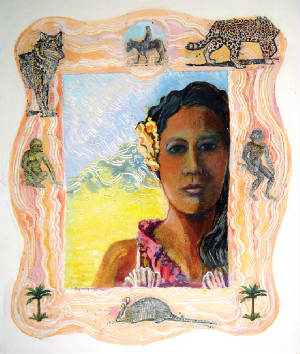
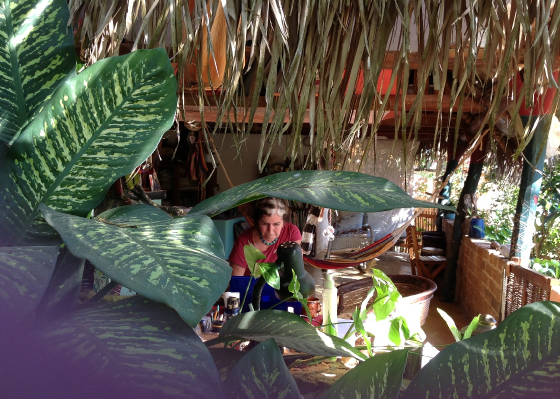
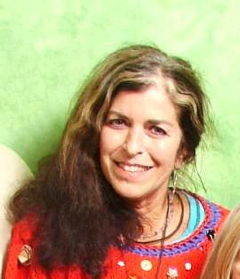
|
|
Books Thank you for your interest in
my short stories, my Folk Art Books and my Art. Here is a brief overview to the books
listed below: BOOKS AVAILABLE 1.Mose T From a to Z: The Folk art of Mose Tolliver By Anton Haardt
From
inside the book What people are saying - Reviews Watch a trailer about the book here You tube
Read Sample Listen audio View Video Buy book 2.Run Toward the Sun Remembering Juanita Rogers By Anton
Haardt From inside the book
What
people are saying - Reviews Watch a trailer about the book here You tube Read Sample
Listen audio View Video Buy book 3. Wisteria Pentimento: Haardt to Haardt, An Anthology of Short Stories By Anton Haardt
From
inside the book What people are saying - Reviews Watch a trailer about the book here You tube
Read Sample Listen
audio View Video
Buy book 4. Let's Get Lost: Raquachismo, An Anthology of Travel Journal Vignettes
By Anton
Haardt From inside the book What people are saying - Reviews Watch
a trailer about the book here You tube
Read Sample Listen audio View
Video Buy book
5. Santo Negri: The Most Expensive Hotel By Anton Haardt
From
inside the book What people are saying - Reviews Watch a trailer about the book here You tube
Read Sample Listen audio View Video Buy book
|
|
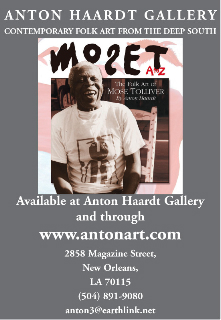
Montgomery's Anton Haardt with her book Mose
T From A to Z: The Folk Art of Mose Tolliver has been awarded the prestigious
Nautilus Silver Award and New York Book Festival Art/ Photography Award The Book is
an intimate portrait of unique African-American who saw fame in his own lifetime after a disaster caused
him to pick up a paintbrush. The photographs , the art work, and poignant quotes by Mose offer
powerful images, touching the South¹s natural soul. Anton Haardt lets us see beyond the artist into the personality
of a complex man who took defeat and turned it into victory. It is a great book for fans of Mose,
aficionado's of folk art, curious readers everywhere and libraries daring to blend art school painters with untrained artistic
genius. Interactive Mose T book available in 2015! *Please see the link:
http://www.youtube.com/watch? v=Rhxzu50aEPM&list=UUmEcNggzIpx_3yP1PMmiIzQ&index=2
Mose
T A to Z: the Folk Art of Mose Tolliver In the winter of 1982,
the American art world was jolted by a controversial exhibition held at the Corcoran Gallery of Art in Washington, D.C. The
morning after the opening reception, art editors questioned in newspapers across the country, "Is this art?"
This groundbreaking exhibition, Black Folk Art in America: 1930-1980, brought
together for the first time the work of America¹s greatest living folk art masters. The exhibition¹s organizer,
Robert Bishop, even went so far as to declare that the work of one artist in particular was of "equal value" to
Picasso¹s, suggesting that "you can hang him beside a Picasso and you have the same creativity and deep personal
vision." That artist is the subject of a book
by Montgomery native Anton Haardt, titled,Mose T. from A to Z: The Folk Art of Mose Tolliver.
Available now, this full-color, 90-page volume is the first book to be devoted entirely
to the life and work of the last surviving artist from the Corcoran exhibition. In it Ms. Haardt relates the story of
Mose Tolliver¹s turn to painting after a crippling accident left him unable to work. She charts the evolution of
his career, from the days when he hung his paintings in a tree in his front yard in Montgomery, Alabama, selling them for
a dollar each, through his rise to renown in the folk art world and far beyond. Additional essay contributions from scholars
Lee Kogan and Regenia Perry situate Tolliver¹s work within the history of American folk art and discuss the stylistic
originality of this visionary American artist. We
know you will want to join us in celebrating Mose Tolliver¹s incredible story. For additional information on Mose
Tolliver you may visit the website for the Anton Haardt Gallery in New Orleans at www.antonart.com. Book Review Quotes: "In terms of the art history of our country, I would say in comparing Tolliver's work to Picasso
- Mose's art is of equal value - you can hang beside a Picasso and you have the same kind of creativity and deep personal
vision." Robert
Bishop, Director of the American Folk Art Museum "Haardt leaves no doubt that Mose Tolliver has made a lasting contribution
to the cultural memory of the South" Jason Berry, Best Selling Author "Locomotives behind artists are as necessary
as the art itself, and thanks to Anton Haardt, many of our regional artists have been able to live and even flourish from
their craft.” Nall - Artist, Writer, Director of Nall Foundation "Bill and Hillary Clinton gave Ted and I a Mose Tolliver painting as a wedding present.
I smile every time I pass it no matter what else my day has brought me. That's art." Mary Steenburgen,
Academy Award Winning
Actress "I must thank Anton Haardt for sharing Mose's story with us. It¹s an excellent story and
excellent journal of an amazing artist who will see fame in his own lifetime after a disaster that caused him to pick up a
paintbrush and share his inner thoughts with us." Tyrone V. Banks, Author of "Under the Melting Pot" "Mose
T, A to Z is the first book dedicated to Tolliver's work... Haardt's true heart comes through in this book... a worthy investment
for fans of Mose, aficionado's of folk art and curious readers everywhere". Clarence V. Reynolds, "Black Issues" January-February
2005 "Haardt gives a brief, yet highly informative, definition on each of Tolliver's whimsical monikers
for his paintings. This book should hold a special appeal for those who have come to know and love the old man on Sayre Street,
and may capture interest of art enthusiasts worldwide." Cane Bowden, "Kudzu Review," Montgomery, Alabama August 2004
Book Awards Mose T A to Z:
The Folk Art of Mose Tolliver has received the following
Awards: A Silver seal in the Nautilus Book Awards 2008. This is a
national competition to recognize books that can change the world. . This contest recognizes the contribution of independent
presses and self-published books in bringing new ideas to the marketplace, similar to the way that independent filmmakers
have reshaped the film industry, according to Ellen Reid, the publisher and book marketing expert who originated the contest.
The Silver Nautilus award for Mose T A to Z: The Folk Art of Mose Tolliver by Anton
Haardt was in the category of Art Genre recognizing not only the Photography but Font and
Design.. The Nautilus Award is an ongoing national competition in 24 categories celebrating literary contributions to positive
social change, spiritual growth, conscious living, wellness, and responsible leadership. New
York Book Festival Award, First Place Photography 2008 Gold Award and Silver Award Creativity 38 Annual Awards
2008
|
|
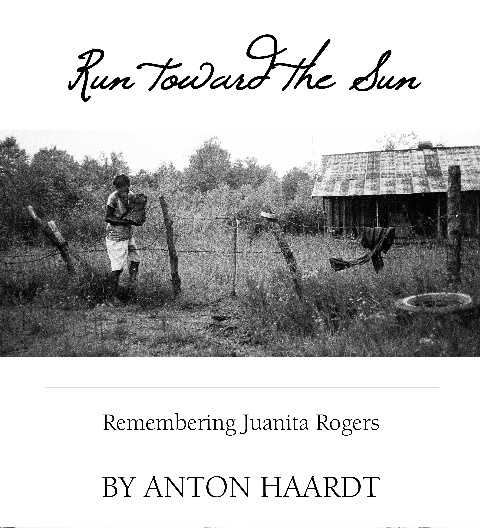
Run Toward the Sun: Remembering Juanita Rogers By Anton Haardt Run Toward The Sun: Remembering Juanita Rogers ia supernatural Photo Memoir of Juanita Rogers, a black self- taught
artist from the South . This is a story about a African -American woman and a young priviliged white woman
-both artists . Behind this double biography is a soulful sub-text that acknowledges the force of friendship, and the fears
and strengths that shape and change the lives of not only these two women, but all of us. A story of two bold women, both
who chose not to make safe choices. One is rich and one is poor. Both are from the South, and both are artists. They
become friends. Through their eclectic friendship, each on their personal quest, they travel through
their own rite of passage and gain a better understanding of themselves and each other.-----a story
woven with a curious thread...and the devil may care duet of this unusual friendship is true. I first met Juanita Rogers more than thirty-five years ago, and became a frequent visitor to her
home near Montgomery. Over the years I amassed many hours of audio and video-taped interviews with Juanita
Rogers and her rural primitive surroundings, and photographed her and many of her creations. The book is filled with Photographs and quotes from Rogers
. The book also contains one essay on Juanita Rogers and her work. Folk art scholar,Tom Paterson, has provided an
art-historical appraisal of Juanita's sculptures and paintings. Hers is a story of an incessant drive for creative expression amidst poverty, social struggle,
and tremendous physical disability. Anton
Haardt SUMMARY Folk artist Juanita Rogers was an uneducated black woman living in a dilapidated
shack outside Montgomery, Alabama. She had a powerful creative talent and mystifying spirit. Juanita´s crumbling sculptures
were made of mud, moss and bones: frightening evidence of compulsion. The hauntingfigures were part of Juanita´s stories
of magic stones, nuns and graveyard dirt. Much defied logic. I visited her regularly and eventually became her confidant and
the mender of her mud creations. I choose not to dismiss her as crazy but instead to explore the mystery of her creative drive.
Our challenging climb to friendship continued til her death in 1985.The two of us through our struggles transcended our barriers
and together united to preserve and further Juanita's mission. Run
Toward the Sun is the celebration of this unique and obstinate
artist and my quest to document and elevate her life´s work.
BEGINNING In the intense heat of summer in Alabama, my life changed abruptly with a ringing telephone. While painting
in my studio, a Social worker called seeking my assistance with self-taught artist Juanita Rogers. Juanita , a dark skinned
proud woan, lived in a dilapidated shack and was destitute after the recent death of her husband. Her porch was filled
with haunting clay sculptures: Ram men and Jungle women that resembled the animal-man masks of the Ivory Coast of Africa.
Intially she distrusted my offer of friendship but through regular visits she slowly letting me enters enter her
world, view her at work, and document her stories and memories. We formed a pack: I would help her with financial assistance
in exchange for drawings.
MIDDLE
I investigated her world and she gingerly unfolded
to me her stories of carnival trains nuns her illusory mentor , Stonefish. Her stories tangled my reality, and much
of what she said contradicted and defied logic. Mr. Stonefish was an enigmatic character and forever absents. Her sculptures
were reminiscent of voodoo but she denied any participation . The chronicles I made of her life was laddened with
trails and our friendship was an uphill climb in which often she would not cooperate. I doubted my job with her and its intrusion
on my own life. My home had become a mud hospital and my constant errands for Juanita took time away for my own artmakeing.
Then in a strange twist one day she pointblank asked me if I was Stonefish...Verifying that she had never really believed
her own stories. Feeling somehow that I could be her magic man , Mister Stonefish, and that she had trusted me finally gave
me courage to continue.
ENDING
Besides her constant money issues, she had
an ongoing health problem that she refused to deal with. She refused medical assistance. Not dealing with her health in a
responsible way eventually causes her health to deteriotrate and finally she was unable to live in the rural area
unattended. I reluctantly had to commit her to a hospital against her will or I knew she would die. This betrayal further
unleashed doubt or questions as to what I should have done .The responsibility was a burden. Shockingly even though she at
first threaten to blow of the heads of the doctors she quickly accepted her change and even seemed to enjoy the
attention. Sadly the cancer had spread to all her body. As her condition worsened she let me comfort her and be her
caregiver. Finally she trusted me. An abrupt end was coming and I sadly was losing my good friend. They lowered her
casket into the red clay--the dirt that she so loved. REFLECTION Juanita and I shared an equal distrust of others , but in the end our Trust for one another `prevailed. Juanita realized I appreciated her and her
work. She showed me some of the primal spirit, so often lost today in our modern world.... The rhyme of self freedom Uninterrupted
by an overdose of intellect. By breathing life into her sculptures and sharing them with me she symbolically revived
herself and me. Juanita affirmed that through the process of creating one can reassemble reality and conquer fears, dreads,
and alienation and find strength in ones self. Art can be more than a pretty picture to look at...also art can be nourishing
and more important a powerful charm.
By way of comparison, Run
Toward the Sun: Remembering Juanita Rogers bears thematic similarities to Los Angeles Times columnist Steve
Lopez’ non-fiction book The Soloist, in which Lopez, a relatively privileged Los Angeles
journalist, befriends and assists a mentally ill man who lives homeless on the Los Angeles streets but turns out to be
a musical prodigy and dropout from New York’s Julliard School of Music. Lopez’ book was recently turned
into the popular Hollywood film of the same title, in which his character is played by Robert Downey Jr. and the homeless
musician’s character by Jamie Foxx.
|
|
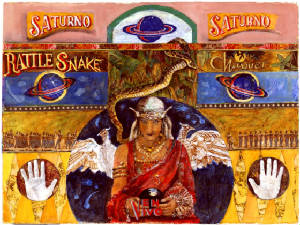
Wisteria
Pentimento:Haardt to Haardt-A Southern Short Story Anthology By Anton Haardt If Sara Haardt is the
Empress of Southern gothic writing, then her niece Anton Haardt is perhaps the princess. The stories perplex, confuse, amaze
and make you happy that people can write like this. This
book of Southern fiction short stories create characters reveal the mind,
heart and skin.The stories are richly illustrated in photo-collages, mostly from Anton Haardt's
shetches, Photographs , and Paintings. The intricacies of
human relationships are the primary theme in this collection of short fiction. Anton , like her Aunt Sarah Haardt's work,
combines wonderfully wicked humor and an astute perception of human psychology. Their ear for dialogue is superb and lyrical.This
is a remarkable compilation of short fiction. Anton Haardt’s creations proves
that blood runs thick- seperated by a generation
they both write from the "Haardt"
"My aunt, Sara Haardt, a Southern expatriate writer who died young of tuberculosis
, married H. L. Mencken, the famed Baltimore critic in 1930.Now with a revived interest in her life andwritings, this Anthology
is in Memory of my aunt and includes a few of her southern genre short
stories with illustrations" Informal in style, this collection of the two
writers work explores how daily life and writing has been a part of both their lives and a remedy of their love hate
relationship with their heritage in the Deep South. Each shared some of the same fears, and experiences. Sara Haardt and Anton Haardt, the last line of the Haardt family, possessed both
beauty, brains and ambition. Also, both were lucky enough to be born into families that had the financial wherewithal to provide
them with every advantage. They attended the best schools and shared similar social experiences together, even dating the
same type of boys. (Both attracted to "the savant") Anton Haardt kept personal
journals since she was a teenager, filling countless
cloth- covered journals with her writing. Although she is known as an artist
and collector of folk art, she also is an accomplished writer. Some of her essays have been
published in periodicals such as England's "Raw Vision Magazine"
and in books such as Bill Arnetts "Souls Grown Deep:Vernacular Art of the South".
Anton also fled the south for similar reasons as did her Aunt Sara, and
as her aunt Sara , Anton's stories share similiar subject
and style...only created some 50 years later.
This Anthology
of stories by Sara Haardt and Anton Haardt show an interesting bridge between a century of two southern
writers. Anton
Haardt has illustrated a few of her Aunt's stories in this collection. One especially
is the short story , "The Rattlesnake Charmer". Written in 1917, this story won her first acclaim
in her writing career with the Award. The story takes place in a southern town where the
daughter of a prominent family takes off with the travelling circus to become a rattlesnake charmer.
Anton
Haardt's stories are sometimes based on real characters
like "The Auction", about Belzora Kemp Basker , a 94 year old heiress of Selma. Another
story, titled-" Miss Bessie", is a story of a spinster woman in Montgomery who might have been
the subject of another famous Montgomery writer's story. Zelda Fitzgerald, Sara Haardts good
friend, wrote a short story of a very similar spinster -titled "Miss Ella",
but in rough manuscript Zelda had titled the story "Miss Bessie" -
One
character in a short story by Sara Haardt
was a confederate war hero,buried in a glass coffin mausoleum. His
beard grew and his finger nails long and curled until one day in 1906 a vagrant broke the glass to steal his solid gold war
medal on his chest. He is entombed in Oakwood Cemetery, a historic Civil War cemetery covered in gnarled oaks and draping
magnolias.A similiar
story written by Anton Haart takes place in the same Oakwood Cemetery-
about two heiresses from Froggy Bottom. They search for truth and honesty in a vengent world of
wicked weejuns and polo shirted golfers. To balance their wealth , their heritage , and understand their
being, they return to the deep south to reclaim what's rightfully theirs.
This epic scenario of 90-year old fathers , blue haired mothers , and neer do wells , they claim what is theirs. . Quotes on the
Back Cover "Haardt combines things seen with things imagined. Patterns
from Mexican clothes might emerge later as a decorative border around a turtle. She offers us languorously
flowing forms along with colorful and exotic visions that transport the viewer to a world of exciting escape.” Mitchell
Kahan
Mitchell Kahan is visual arts critic, and former executive director of the Akron Art Museum
in Akron, Ohio
"Her
creations read like vignettes and offer portals into the world in which Haardt lives and creates. While
they provoke numerous attempts at serious interpretation they may be seen also as flights of fancy, or collections of cherished
objects like a child’s secret treasures, primitive yet sophisticated at the same time." Jim Upchurch
Jim Upchurch is
past Editor for The Montgomery Magazine, Montgomery Alabama
"It is because Anton understands so well the perspacity
of the child in us all that she is able to transcend the passivity of pure form . . . and it is through this marvelous consciousness
that she converts by magical symbols her fears and dreads into her own greater magic. Her pictures are
indeed charming but they are also powerful charms.” Thomas Moore
Thomas Moore is
an Artist and former Art Professor at Huntingdon College, Montgomery Alabama
“Haardt’s dark eyes, intense and probing, bore into you making
you wonder what’s she’s discovering inside, what secret’s she dredging up. The very molecules around her
seem to be in a wild explosion”.Henrietta McGuire
Henrietta McGuire is an Author, Editor/Founder of River Region Magazine and former First Lady
Of Costa Rica
“She uses symbols from the primitive side of Latin America and the Caribbean, and their
kindred Southern Black Folk Art. Pattern and decoration is also a reflection of her life—luxuriously
decorated with spontaneous patterns of isolation and travel: isolation from middle-class virtues and freedom
from the puppet-like routine it implies.” Nall Hollis Nall Hollis is an Internationally known Artist , protégé
of Salvador Dali, and Head of the NALL Foundation
"Haardt
is Montgomery’s prodigal daughter, returned home with treasures from afar. She .infuses the tropical
sensuality of her life in the jungle of Yelapa, Mexico, with the street fever found in the decadent and subversive city of
New Orleans, which she also calls home. Haardt, both invites and repels, as in her painting of ”The
Snake Charmer”, The hypnotic stare of the snake charmer promises secrets to behold, but she's flanked by two out-turned
palms guarding her like sentries and warning all those who dare to enter.” Nancy Jarzynko
Nancy Jarzynko is Costume designer or various Films,
such as “The Big Fish” Let’s
Get Lost:Raquachismo: A Journal of Short Stories By Anton Haardt Raquachismo is a slang term from the Spanish raquero - to
plunder wrecks / /chismero - tale bearing gossip
Let’s Get Lost: Raquachismo: Travel Vignettes is an intimate journey into the lives of obscure
people and places , revealing the spirit and soul of a place. It is an anthology taken from the
past twenty -five years of my journals, with illustrated drawings and photographs. Initially I thought I would have it printed just as ordinary
text. I finally decided that the two, the story and the imagery were inextricably linked.
It would have been ashame not to show the pages with added imagery. I don’t think about these labels much,
but it is not just ‘a short story’. I think of it as ‘a collaged story”..
Anton Haardt
"In Haardt's meanderings and her
observations , she is struck by the irony and the ecstasy of a Oaxcan peasant woman carrying a perfectly iced
white wedding cake...on her head; or caught on a crowded zocolo in a Manaus rubber plantation boomtown on market day; or sensing
the feel of, and the weight and smell of a decapitated pig's head happily being held by a small Honduran boy....A fast
and furious flight through the miasmic annals of Haardt's cabal is the only way to travel when you're suffering
from the been there, done that, blues. She is a latchkey writer of the twenty-first century still wondering why
nobody is at home, and here begins the still to be continued journey." Xenia Zed Xenia
Zed is Director of the Hambridge Center for Creative Arts and Sciences in Rabun Gap, Georgia, Editor
in Chief of Art Papers Magazine and Assistant Dean at the Atlanta College of Art, BOOK COVER QUOTES
“Coming from a root bound
Southern family, I took flight. I was drawn especially to the primal and primitive, Indian tribes, tropical
animals and fauna, bringing their jungle into my life and art. I paint sometimes like a palmist, not knowing
what fortune I will find until I look closely. In my art I play, I contemplate, I learn, balancing order
and chaos.” Anton Haardt
“Born
in 1948 in Montgomery, Ala., Anton Haardt studied at Washington University in St.Louis and later at the
San Francisco Art Institute, from which she received her BFA degree in 1971. Haardt’s prints, drawings,
collages and assemblages have been exhibited in New Orleans, Montgomery, Key West, as well as Paris and several cities in
Mexico. Resulting from her travels to Central and South America, the Caribbean and North Africa, Haardt
combines things seen with things imagined. Patterns from Mexican clothes might emerge later as a decorative
border around a turtle. She offers us languorously flowing forms along with colorful and exotic visions
that transport the viewer to a world of exciting escape.” Mitchell Kahan Mitchell
Kahan is visual arts critic, and former executive director of the Akron Art Museum in Akron, Ohio
“There
is in Haardt’s work a sense of private spectacle and public ritual. The spectacle is found in the
fetish aspects of symbols and signs used in the works; the ritual character is revealed in their repeating patterns and ordered
surfaces. Haardt’s work displays a disciplined imagination and technical skill of considerable sophistication creating
a personal appeal associated with piqued curiosity.” James R. Nelson
James R.
Nelson is visual arts critic for The Birmingham News, and former executive
director of the Alabama School of Fine Arts.
“By using kitschy, ordinary elements and presenting
them in a sacred shrine-like format, Haardt dares this work to be taken seriously, and seems to call into question what constitutes
art, its message, and its elements. Perhaps Haardt is asking us to reexamine the ordinary elements in our
own lives and see what art can be found there.” Christine Neal
Christine Neal is
past visual arts critic for At Papers, and Curator of European and American Art at The Museum of
Art and Archaeology at The University of Missouri at Columbia, Missouri , B.A., Bucknell University; M.A., University
of Wisconsin; Ph.D., University of Missouri.
“The drawings, sculpture fabricated from found objects, and shrine-like shadow boxes that
utilize innovative reproduction methods, demonstrates Anton Haardt’s range and depth. The shadow
boxes read like vignettes and offer portals into the world in which Haardt lives and creates. While they
provoke numerous attempts at serious interpretation they many be seen also as flights of fancy, collection of cherished objects
like a child’s secret treasures. The repetitive motifs used for background or framing behind or around her primitive
yet sophisticated paintings, collages, and prints are subordinate to the subjects yet tied to them with artistic unity.”
Jim Upchurch
Jim Upchurch is
past Editor for The Montgomery Magazine, Montgomery Alabama
“Anton is the child/conjuror. Sacks
of torn paper, potato-stamp stencils and assorted scraps of cryptic images are her tools from which she plumbs talismatic
messages from her own psychic depths. Anton becomes in her artmaking a kind of magician re-experiencing
in each piece the ancient ritual of summoning form out of formlessness, order from chaos. It is this totemic
component of Anton’s work that gives it its electricity and separates it from the kind of superficial quaintness characteristic
of most folk-type art. Her collages in particular are childlike in execution disdaining the facility her
years of formal training has given her. It is because Anton understands so well the perspacity of the child
in us all that she is able to transcend the passivity of pure form . . . and it is through this marvelous consciousness that
she converts by magical symbols her fears and dreads into her own greater magic. Her pictures are indeed
charming but they are also powerful charms.” Thomas Moore
Thomas Moore is
an Artist and former Art Professor at Huntingdon College, Montgomery Alabama
“She uses symbols from the primitive side of Latin America and the Caribbean, and their
kindred Southern Black Folk Art. Pattern and decoration is also a reflection of her life—luxuriously
decorated with spontaneous patterns of isolation and travel: isolation from middle-class virtues and freedom
from the puppet-like routine it implies.” Nall Hollis Nall Hollis is an Internationally known Artist , protégé of Salvador
Dali, and Head of the NALL Foundation
Santo Negri: The Most Expensive Hotel By Anton Haardt This novel is a Black Comedy/ Southern Gothic based
on a true story of intrigue. A story of a trio who travel
through the back roads of Mexico and the jungles of South America in the 1970's. On their journey they
encounter many Alice in Wonderland absurdities - culminating in the imprisonment of
one of them in a 100 year old Mexican Prison for drug smuggling. The story can be compared to Kiss
of the Spider Woman, with a blend of Rashoman's Kurasawa . The prisoner, with help from friends , miraculously
escapes through the sewer pipes and all head for the border. This story is told to a "Bag Lady" named Hurri on a Greyhound Bus trip,
remenescient of the style of "Fried Green Tomatoes", the Fannie Flagg story told to a young girl
by an eldererly Nursing Home patient. Santo Negri is not just a prison break but the study
of a relationship whereby a couple is isolated together one by free choice and the other
by imprisonment and what transpires in their year together in this strange Latin setting.
The trio, Jay, Martha and Eve,travel through the back roads
of Mexico and the jungles of South America in the 1970's. On their journey they encounter all sorts of "out of
the box" scenarios that goes sour when the Mexican Prison chamges their lives . Eve,
leaves her comfortable life in the US and goes
to Mexico to try to rescue him. Instead she ends up
by her own volition, spending the next year
inside the prison visiting him. Jay eventually escapes through the sewer lines where he navigates (ex-Navy pilot) through the darkness by
"reading" the shadow angles formed by rare slivers of sunlight filtering into the
black sewer. The two women and other friends involved in the jailbreak must all sneak back over
the border to the U.S.
The
story blends Kiss of the Spider Woman, with a little of Rashoman's Kurasawa . Like in Rashoman's Kurasawa
there are three different participant accounts of the same incident.
Where does truth lie? Why do they create and tell stories? To search for truth or to help forget the pain and suffering that
surrounds us? Who tells the story and why? What do they have at stake in their narrative? This story is also the study
of a relationship whereby a couple is isolated together one by free choice and the other
by imprisonment.Their relationship is all to sustain them in
the long hours that they are “incarcerated” together. Life unfolds in their year together in
this strange Latin setting and the book invites you into their world, reminding you how glad you are that
you werent really there,although you feel like you were.
Setting
Early 1970s, a few years after the time
when Timothy Leary was urging American youth to “tune in, turn on, and drop out". I was a time
when much of the youth had left home and had gone searching, like others of this generation, for utopia,
inner freedom, and “higher consciousness". Santo
Negri was an eerie, ancient decrepit 19th
Century French built prison that housed the great Mexican Revolutionaries such as Zapata and Poncho
Villa. Towering stone turrets accented the various wings. The sense of a Boris Karloff
castle built by some mad architect that now, in the 20th Century, had become a madhouse. The
prison stood like the House of Usher, so dark and foreboding were its cold, stone veneer
and gothic iron bars confining the prisoners inside. It was known by the prisoners as "the most expensive hotel in the
world", because of the mordidas, and corruption.
Several
vignettes South America 2 a.m.
-The Trio take a long foreboding trek into the deep Ecuadorian jungle in search for a dysentery
treatment by a famous Tribal Shaman and shockingly find in the heart of the deep jungle electricity
which is used only to run one Coca Cola machine . The Shaman an spits fire, becomes intoxicated by some
200% Moonshine Jungle juice and scares the Trio out of their skins. Mexican prison: Inmates' families
can visit almost daily privately in the cells. Strawberries, celery, platform shoes, blue skirts are not allowed in, but heroin,
drills, hack saws are readily available.The "king" of one cell block has life-sized portrait of himself in his cell.
Eve's small living quarters in
the center of Mexico City's Zona Rosa, where she lived alone, scared and miserable, visiting
the Prison daily: I had a apartment room on the second floor room on Calle Hamburg
22 ,a narrow street lined with older 2 story homes. My room was a Victorian bed with a pink headboard in
a ederly German lady's home. Then later I moved to Boarding house and my small roon had a small twin bed and a bare overhead dangling
light bulb.My darkend room with no windows, no view made my room even smaller and
my whole life even dimmer. I shared the small bath with the other tenants,
one was a transvestite guy who took fore ever with his shower plucking his eyebrows ."
Characters Jay , a charming, moody and irresponsible is very manipulative and will only
accept admirers who highly esteem his intelligence. However, these devotees are not to notice that his problems result from
his not too smart impulsive actions. He is masculine, with dark blonde hair tied
in a long ponytail and bearded. He’s charismatic, good-looking in a way that sometimes seems only safe in
dark alleys. But then there’s that tattoo, a faded black Falcon on his arm and
on his thigh a small blue tattoo of a Hummingbird. Charming as he may be he can’t hide that ink, nor what it says about
his character: This is a man, half with sensitivity of a hummingbird, but the other
half is that he may burn anyone down who stands
in his way. Jay is also often a crazed over the top guy who often
drank long and hard, but at moments his genius slips through. Jay,
fairly predictable as a self-serving figure, is the counterpoint to the other characters. (i.e., Jack Nicholson in Five
Easy Pieces and William Hurt in The Big Chill.) Eve, 26 year old Southern dropout heiress, with a VW bus. Her long
black hair frames her tall thin sinewy frame. Her favorite
attire is a blend of Paisley skirts and Guatemalan shawl. A great
teller of tales, honest spirit. She cares deeply, gives time, humor, friendship, and
money if needed .Her demeanor is eccentric and she chases around the world
to escape the debutante proper life expectations of her traditional upper class Mississippi
parents. She is heir not only to their money but to their own unconventional lives. She grew
up in the 1960s in a comfortable household, an attractive and rather gifted girl who
seemed destined to leave her comfortable past and grew restive, started
questioning things, ; started to distrust the conventional life of his parents and the US in general. .
She seeks someone who will understand her, someone she can open up to and, finding it in no one but
Jay, decides to go to the Prison to help
him. . During the many hours she and Jay spend alone in the jail, she wonders why
she is there. Eve is the interesting half of this
isolated jail cell relationship between one with absolutely no freedom and the other with freedom of movement but emotional
constraints. Jay is the prisoner, but in reality his wants to imprison Eve and determine all of her actions.
Martha ,
could be any middle-class girl originating from the 1960s, growing up in Atlanta Georgia.
A gentle soul who raised French lop-eared Rabbits, contrasts with her unpaid
dues to her membership in the Wicca Order. of Witches, She is petite with light
brown wavy hair and youthful bangs that framed her innocent
round face. She preferred to wear dresses long and flowing. She wore flat earth Shoe
style sandals accentuating her small round feet. Her pale floral blouse with floral appliqués
with her cropped lace tank top underneath is the perfect combination that broadcasts "I am a flower child”, but
in a gentle, feminine way. She had graduated from Secretary College.
Academically did alright: got the usual A’s and B’s. She yearned for Adventure,
and moved to New York. During her brief but intense incarceration
in the Mexican Prison , her observations and emotions are filtered through her rather uncommon diary
of her two weeks inside the prison of Santo Negri. There, she is able to connect at
least to one thread of sanity
through the words written in her diary for her momentary
salvation .
The Plot The three share
a conviction about adventure and leave for South America. Eve, 26 year old Southern dropout heiress, travels
by VW bus with her 32 year old boyfriend (ex- executive) and his 24 year old ex-girlfriend through Latin America.
They traveled thousands of miles, first to Mexico then down
the Coast to Colombia Ecuador Peru Bolivia . Martha is
the strong traveler always knowing where she wants to go and
experiencing every moment , often in a self
indulged way. Eve is unsure and timid , never being able to make up her mind. For the next year they melt
into the new culture. Jay, a often , moody, abandons the women and flies
back to the U.S. several times despite his lack of funds. They all finally return to
the US, but later Jay decides to coerce Martha to go back to
Colombia to help Jay smuggle cocaine to pay his debts .
Both are arrested and jailed in Mexico. Eve comes to their rescue
and flies there to help. She voluntarily spends one
year and half visiting daily inside the prison
doors. Trying unsuccessfully to get his release Through
this all three each had come to a realization that thy
had no ability to frame the solutions to their problems or even how to clearly identify them. Each
determines a way to deal with that issue. To escape reality of the squalor,
and the brutality of prison Jay (often seen as the “bandit”
character) reverts to drug use to survive, and invents ingenious
methods of escape to occupy his time, while Eve tries to keep her mind on the situation she's in,so
she can tend to her new responsibilities ..to bring food, money, projects
for Jay to do. During the time they spend together, the two come to understand one another in a
strange way. The fact that both are incarcerated--
Jay locked in a his cell and Eve imprisoned willingly is
a vital part of the story. A darker, more violent, more threatening version of the classic Odd Couple
story. Jay is inescapably caught in a web of his own making. He
may not be able to escape his own emotional problems, but he is driven to at least escape from
his current address. We’ll soon see that Eve is incarcerated in her own
way and needs to escape as well. Jay and Eve are similar in an
odd way to Luis Molina and Valentin Arregui , the cell mates in a South American
prison in the story of Kiss of the Spider Woman. You’re aching to move But you’re caught
in the web Of
the Spider Woman In her velvet cape. You can scream, But you cannot escape Jay eventually
escapes through the sewer lines where he , in genius style ,navigates (ex-Navy pilot) through the darkness by "reading"
the shadow angles formed by rare slivers of light. The two women and other friends involved in the jailbreak
must all sneak back over the border to the U.S.A. Decades pass, and the trio each go their own way. The years changed them, some for better and some for worse. Then one day the
girls,now middle aged women, hear
that Jay has killed himself. "Hurri"
, the Bag Lady listens to the entire story until the Greyhound Bus reaches its
destination in San Francisco, (where it all started so many years ago) But she has her own
opinion of what really happened.
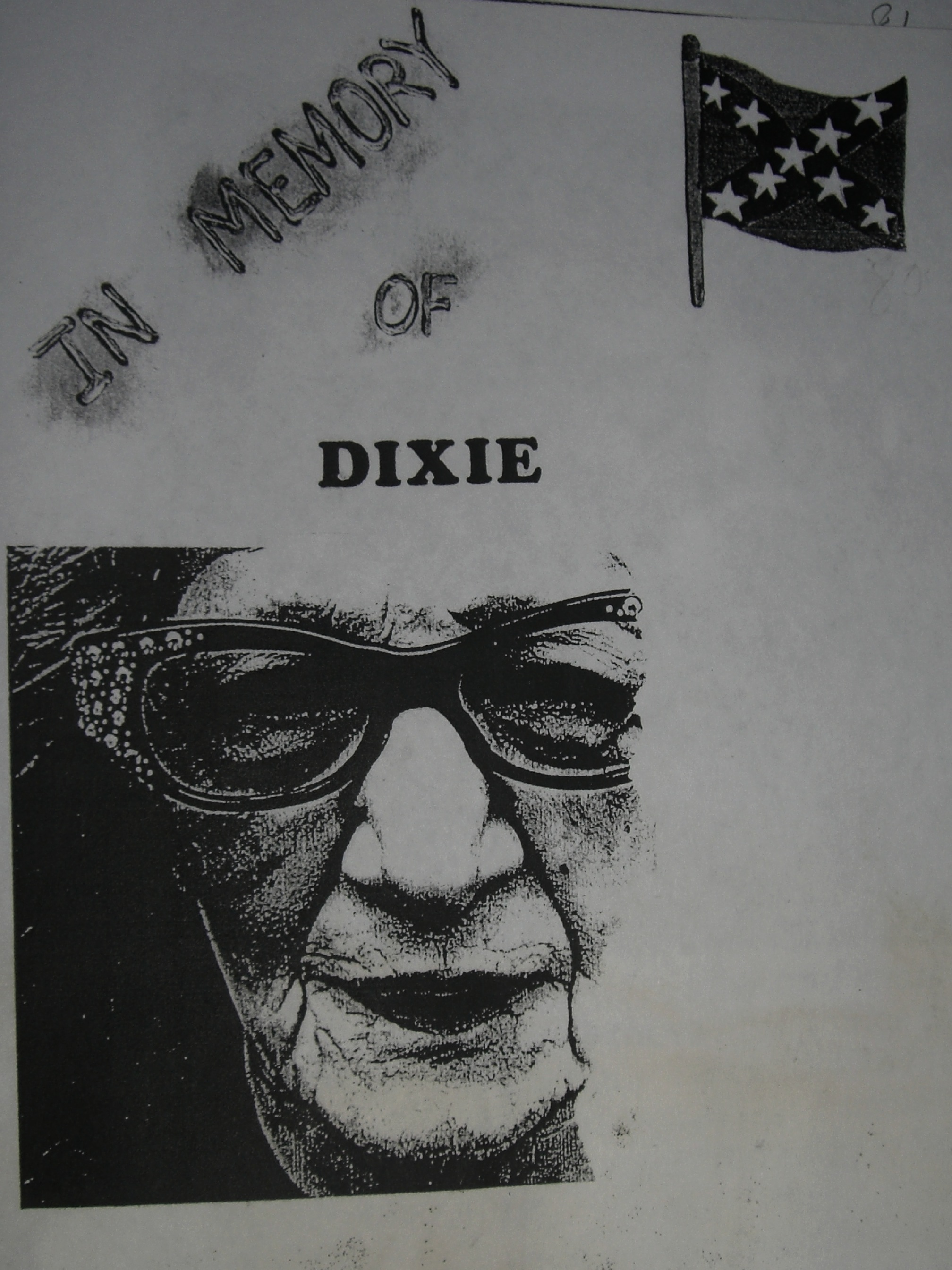
|
 |
BOOK REVIEWS 1. Vision Seekers Outsider artists
such as Sister Gertrude Morgan often come to public attention thanks to their unique -- and sometimes controversial -- relationships
with art world insiders. By Jason Berry *Excerpt
As Bornenstein
was drawn to the passionate visions of Sister Gertrude's work, Anton Haardt felt a magnetic pull to the
pink "dinosaur birds" and strange shapings of fruits, animals and human bodies that Mose Tolliver, working on scrap
wood, was selling in his yard "Mose Tolliver used to hang his paintings in a tree outside his home in Montgomery,
Ala., pricing them at one or two dollars a piece," writes Anton Haardt in Mose T. From A to Z: The Folk Art of Mose Tolliver,
a forthcoming biography, lushly illustrated, by the woman whose eponymous Magazine Street gallery has perhaps the city's most
extensive inventory of high-quality works by black Southern folk artists. The daughter of a wealthy Montgomery real estate agent, Anton Haardt earned
a bachelor's degree in fine arts from the San Francisco Art Institute and was starting her own career as a painter in 1969
when she saw Tolliver's paintings outside his house. Tolliver had been crippled several years earlier in an accident on the
job at a Montgomery furniture store when a crate of marble fell from a fork lift, crushing his left ankle and destroying the
muscles and tendons in his legs. Forced to use a wheelchair and crutches, he threw himself into painting "to keep [my]
head together," he said later. Haardt
began buying pictures from Tolliver. "Mose didn't have much in his bank account," she says. He would sell paintings
to her for $10 each. She would drive to New Orleans and sell them to Russell Gaspardi, who had a gallery in the Quarter, for
$20 each. "Gaspardi would sell them for $75 a piece," she says. "I'd give all the money from the sales to Mose,
and he would give me two paintings in return." Tolliver's imagination had
a vivid erotic streak in his bulbous female figures, which would hardly have endeared him to Sister Gertrude. He also generated
a stream of self-portraits -- a man with walking sticks, and heads that resemble animist masks. "Mose and I became very close friends," continues Haardt. "I was also doing
a lot of traveling back then. I didn't want him to lose anything on my account." Others, including Gaspardi, began making
trips to Montgomery to buy art from Mose T at his home. The friendship that blossomed
between Anton Haardt, a daughter of Alabama's upper crust, and Mose Tolliver, a black man in a wheel chair barely scraping
by, typifies the way in which many self-taught painters found their way into the art market. Haardt kept buying and selling
his works as an agent on a non-exclusive basis. "I love Mose. I wanted to help him," she says. In
1982, Haardt arranged for Tolliver to show his works in Washington, D.C., at the prestigious Corcoran Museum of Art's landmark
exhibit Black Folk Art in America, 1930-1980. "Before we left Alabama I had made a bet with Mose that if we bought ten
of his paintings to Washington, I could sell them for a lot more money than he could ever imagine," she writes. "I
aimed to sell them for one hundred dollars each, a lot of money in 1982, and certainly more than their usual selling price.
After the opening, I was accompanied to my hotel room by several prominent folk-art collectors who were interested in buying
Mose's paintings. Within minutes I had sold all of Mose's pictures and had one thousand dollars cash in my hand. For me, delivering
those earnings to Mose was the pinnacle of our trip." Over time, as Haardt
bought more paintings from Tolliver, she held on to many of them. "I probably have 400 pieces by Mose," she says.
She also purchased dozens of works by Jimmy Lee Sudduth, a rural artist whose figurative paintings, using red-brown Alabama
mud, radiate a warm lyricism.
Although Haardt has made her home in New Orleans for
years now, she makes regular trips back to Alabama to visit Tolliver, now 85, whose health is deteriorating. Tolliver's pieces
sell for $500 to $1,500 at Anton Haardt Gallery, though some of his more stylized works go for considerably more.
The other artist whose work Haardt championed, the late Juanita Rodgers, lived
outside of Montgomery in a shack in an open field. For years, Rodgers made sculptures out of mud. Haardt befriended her as
well, spending long stretches watching her work and interviewing her about her obsession with mud sculptures. Haardt is completing
a book about Rodgers, whose works she has preserved in storage since Rodgers' death.
Anton Haardt's Essay on Juanita Rodgers appears in the
massive 2000 book Souls Grown Deep: African American Vernacular Art. At $100 a copy, Souls Grown Deep was the brainchild of
William Arnett, a pioneering folk art dealer in Atlanta, and his son Paul Arnett. The Arnetts produced a second volume of
Souls Grown Deep in 2001 with financial support from Jane Fonda, who settled in Atlanta after her divorce from CNN founder
Ted Turner. Local gallery owner Anton Haardt's admiration of Mose T's talent led to both a long friendship and working
relationship and a forthcoming book of Mose T's works. Art is a search for all who make things designed for the inner spaces and public
exteriors of our lives. The religious imagery Sister Gertrude Morgan made of her mystical illuminations, the flood of faces
and figures that Mose Tolliver generated after his leg was destroyed, and the mythical sensibility of small folk and heroic
figures in an African-American landscape wrought by Thornton Dial are three chapters in the annals of Southern folk art. Behind
these artists are individuals -- Larry Borenstein, Anton Haardt, Bill and Paul Arnett -- who turned the passion of their own
discoveries into commerce, advancing careers and creating public figures in the process. Jason Berry's essay "New Orleans in the Years of Sister Gertrude Morgan," is included in
the catalogue Tools of Her Ministry. Clarence V. Reynolds,
"Black Issues" Book review
Self-taught artist Mose Tolliver approached his art
if not in a singular fashion, then in a distinct manner from many other artists. After a debilitating accident in the late
1960s confined him to a wheelchair, Tolliver began using house paint, bought on sale, to create images of animals and nature;
and he plopped his creations on pieces of plywood and poster board. This exercise of painting was meant to be therapeutic,
but it proved to be the catalyst for the true artist within him to come forth. Tolliver then unashamedly displayed his creations
in a fashion that was not so unusual in the South--he hung them from trees outside his house in Montgomery, Alabama. In 1981,
Tolliver mounted his first one-man exhibit, at the Montgomery Museum of Fine Arts. His stature as a first-class, albeit self-taught,
artist had come, and his career has been flying ever since.
Yet Tolliver once said, "I'm not interested in
art. I just want to paint my pictures." Mose
T, A to Z is the first book dedicated to Tolliver's work. Haardt, an artist and gallery owner in New Orleans, befriended Mose
and his wife, Willie Mae Tolliver, in the '60s; and Haardt's true heart comes through in the book, as Mose Tolliver's work
is carefully laid out with pictures of the artist, his wife and members of their family. Yet it's the commentary from the
man himself sprinkled throughout the pages, accompanying the images, that makes the book a worthy investment for fans of Mose.
______________________________ Midwest
Book Review African-American art is as diverse, innovative, and reflective of mind, imagination, and cultural
experience as any other form of folk-oriented artistic expression. "Mose T From A to Z" The Folk Art Of Mose Tolliver"
by Anton Haardt is the perfect showcase with which to introduce one of the truly talented representatives of this authentic
American art genre. When Mose Tolliver was injured on the job, he was able to overcome his disabilities by teaching himself
how to paint as a way to pass the time as constructively as possible. After several years of honing his skills as a self-instructed
folk artist, his work was discovered by art collectors and critiques, including the best of his creations being displayed
in such venues as the Corcoran Art Gallery in Washington DC. Artist, photographer, and writer Anton Haardt provides interested
readers with an informative biography and an informed commentary to accompany selected preproductions of Tolliver's work,
including a 'pictorial essay'. Enhanced with a Timeline, as well as art captions, "Mose T A to Z" is a seminal work
that will well serve to introduce a unique African-American artist to an appreciative new audience and should be considered
a seminal addition to personal, academic, and community library 20th Century American Art History collections in general,
and African-American Artist reference shelves in particular. KING KUDZU MAGAZINE
Review written by: Kane Bowden
Mose T A to Z: The Folk Art of Mose Tolliver By Anton Haardt
Haardt blissfully
recalls her aquaintance with Tolliver and his family and how, in his early years, Tolliver would hang his works
from trees outside his home for interested passers-by. The A-Z section
of the book is a perfect introduction for anyone with an interest in Tolliver's work, but has never met the man in person or seen his work first-hand. The full color guide gives 26 examples of Tolliver’s
massive body of works, along with personal quotes from Tolliver himself providing insight on what inspires him to paint a "Jimma Jamma Girl" or a
"Tico Bird".
For us laymans, Haardt
gives a brief, yet highly informative, definition on each of Tolliver's whimsical monikers for his paintings. This book should hold a special appeal for those
around Montgomery who have come to know and love the old man on Sayre Street, and may capture interest of art enthusiasts worldwide.
Book
Review Sunday, April 15, 2007 By Denise Turney
Mose T A to Z: The Folk
Art of Mose Tolliver introduces art lovers and a broad range of eclectic book readers to a natural born, self-taught drawer
and painter they may not otherwise meet. The style the book’s author, a writer, artist and photographer named
Anton Haardt, uses to bring Mose T to readers is indicative of Mose T’s creative style itself. I couldn’t
help but to think that Haardt is perfect to write this book.
The
fact that Haardt is an artist in her own right coupled with the fact that she not only has a strong appreciation for Mose
T and his work but also the fact that Haardt knows Mose T and has known him for more than thirty years lends a credence, a
validity, to the book that gives the book a down home feel. This spirit of ease and familiarity is sufficiently balanced
with a sharp Art IQ.
It is rare, though not as frequently as it used to be
years ago, for a self-taught artist to have his work, that he once hung in his own front yard for passersby to look at and
enjoy and perhaps purchase, placed on display at places like The Smithsonian Institute, The New Orleans Museum of Art, the
Museum of Birmingham, Moore College of Art and Design in Philadelphia, American Folk Art Museum in New York and the Ogden
Museum of Southern Art.
Focus and education about the Folk Art world
is rich throughout the book’s pages. I especially enjoyed reading about Mose and Willie Mae, Mose’s wife
of fifty years and mother of his twelve children, visit to the Corcoran exhibition in Washington, DC. Pictures of Mose’s
work are dispersed throughout the book as are photos of the artist himself as he goes about his every day life, seemingly
unaware of the talent that he holds. Mose’s artistic IQ is innate; the book celebrates this talent spectacularly.
Yet
there is another story buried beneath the art in Mose T A to Z: The Folk Art of Mose Tolliver. It is the story
of the artist himself, not simply the art he created, and the story of the artist’s family. It is the dance, the
love, of a man and a woman who met when they both were children and who went on to share half a century together.
Readers will be inspired by the way Mose T takes up art after a slab of marble falls on his feet at the furniture store where
he worked. Mose T would spend his remaining years, as of the writing of the book, in a wheelchair. To bring Mose
T out of his depression following the accident, a fellow colleague, Raymond McLendon, encouraged Mose T to paint.
The
book clearly illustrates the connectedness of life. An unforeseen accident led a man, Mose Tolliver, to unlock his artistic
talent, a talent that very well may have otherwise remained dormant, a talent that has been shared with and appreciated by
countless people, children and adults, around the world. Mose T did not create to impress. The book’s author
created the book with that same spirit. Mose T A to Z: The Folk Art of Mose Tolliver is a book to be enjoyed and
treasured now and for years to come - just like Mose Tolliver’s work.
HIGHLY RECOMMENDED
BOOK
REVIEW
Title: Mose T A to Z: The Folk Art of Mose Tolliver
Author: Anton Haardt Publisher: Saturno Press ISBN: 0975384201 Genre:
Nonfiction Little-known
artists sometimes receive the recognition they deserve and their names become known to the art world. Such is the case of
Mose Tolliver, a talented, self-taught folk artist. Injured on a job, he took up painting as a way to productively fill his hours. After several years, Mose
was discovered by collectors and his work now hangs in several collections and has been included in many shows by famous galleries
like the Corcoran Art Gallery in Washington, DC. The
concept largely held by society that uneducated people are simple is disproved by men and women like Mose Tolliver. If opportunity
knocks, they prove they have talents that place them in a special category apart from the rest of society. Mose didn't care for the trappings that go along
with success, he said he wanted only to paint. And so he did. The subjects of his work cover a wide range and change over
the years. Author Anton Haardt
lets us see beyond the artist into the personality of a complex man who took defeat and turned it into victory, an example
for all. I'm happy to recommend
Mose T as an introduction to folk art, a field I know little of, and a starting point for learning about the artists who create
that art. Definitely a book worth reading.
Review by Anne K. Edwards 01/17/07 The Story Of A Remarkable Man
Told Through Art.
Title: Mose T. from A to Z: The
Folk Art of Mose Tolliver Author:
Anton Haardt Publisher:
Saturno Press (January 2005) Genre:
Art ISBN: 0975384209000
Hardcover: 90 pages
Rating: Highly Recommended.
July 20, 2005
Well over three decades ago, Mose Tolliver was injured on the job as a load of marble fell on his legs crushing them. To ³clear
his head², Mose began to paint a variety of subjects with the hopes of selling his works for a few dollars or trading them for food. One may call that the
end, but this hobby became
the beginning of so much more.
Anton Haardt,
an artist, photographer and author as well as an inspiration too many in and out of the art world forged a friendship with MoseTolliver. To help him out she
began to show his art to larger galleries. She would try to sell his art work for twenty-five dollars or more as opposed to the one or two dollars that he would normally accept.
In 1982,his work was displayed at the Corcoran Gallery of Art in Washington, DC. At the Black Folk Art in America 1930-1980 Exhibition.
Critics questioned if his art was actually Art...due to the fact that it was so different. Regardless of the initial reaction by the Art World, his work soon developed a market and the demand
and value of his work increased. His unconventional style stretched the boundaries of folk art at that time, but soon after and today, his work is respected
and purchased by people from all walks of life. Today, he is the last surviving artist from the Corcoran Exhibition. Quote by Mose Tolliver: ”I just think of something I want to paint and I¹ll try it and I¹ll keep
working until it looks all right
to me, then if someone buys it it must be all right.”
The world has spoken and his work exceeds "all right." His use of unconventional media such as house paint on wood eliminates
the option of hiding
bad art under exciting and expensive materials. His artwork is true and pure and sought after by a diverse audience. Who pay what some would pay for works by more famous artists.
He used to sell paintings for a few dollars,
but now that has escalated to thousands of dollars. He is a true inspiration to budding artists, causing them to persevere and never give up the part of their own selves
that they paint regardless of the critics! Anton Haardt does an excellent job of explaining in her book the ideas behind Mose¹s work in his own
words. Each painting means something to him and he tries to paint that thought or idea in its purest form. Some of his paintings are done in rich earth
tones, causing the subject matter to outweigh the media. Other works have some sexual overtones but it is handled with charisma and not overdone. He draws inspiration from family members or children playing outside.
His paintings have unique titles such as French Magnolia Lily, Hatching Bird House and Jimma Jamma Girl (use your imagination)! These unique paintings have unique stories and that
is a part of the
reason for their acceptance and appeal. A lot of his works are various self portraits as he draws from himself for inspiration either way, when you see a ³MoseT² with the signature reverse "S" applied,
you know that it
was either painted by him or signed by him.
Pick up
a copy of MoseT A to Z: The Folk Art of Mose Tolliver today and discover the work of a true artist who¹s transition from
obscurity to fame has
been documented by his friend of 35 years. I must thank Anton Haardt for sharing Mose¹s story with us. It¹s an excellent story and excellent journal of an amazing artist who will see fame in his own
lifetime after a disaster
that caused him to pick up a paintbrush and share his inner thoughts with us. Tyrone V. Banks Mose T, A to Z: The Folk Art
of Mose
Tolliver, by
Anton Haardt Saturno Press, 2006 Whether
you refer to him as a self-taught artist or a folk artist, Mose Tolliver is a legend and an inspiration. Disabled when a crate
of marble fell on his feet and legs, Tolliver turned to art in order to keep his head together. But not everyone who practices
art therapeutically gains the recognition that Tolliver achieved. So how did Mose T, as he was known, transform from a gardener/housepainter/shipping employee into
an internationally known and respected folk artist? The answer to this question can be found in Anton Haardt¹s book Mose
T, A to Z: The Folk Art of Mose Tolliver. Haardt and Tolliver could not be more different. As the Foreword notes, Haardt was an ³accomplished young
woman from a socially prominent Alabama family² while Tolliver was a ³middle-aged, partially disabled African American
painter.² But, they were both artists in Montgomery Alabama. Haardt was drawn to Tolliver¹s pictures with
fantastical titles like Jimma Jamma Girl and X-Ray Dry Bones Charlie which were often displayed in his front yard. Neighbors
and artists would often pay him one or two dollars per picture. In this collection of anecdotes and quotes from Tolliver¹s life, alongside an abecedarian
compendium of some of his art, Haardt has given the world an opportunity to know Tolliver the way she did. Haardt even includes
a timeline of important dates and exhibitions throughout Tolliver¹s career. Mose Tolliver died October 31, 2006. He was in his 80s. Haardt¹s book is a must-read for art lovers,
as well as for those who think art is only for the wealthy. Most T showed us all there is art in doing what you love and loving
what you do. 74 pp. Bernadette
Geyer, editor berniE-zine: Book Reviews &
More http://rantsravesreviews.homestead.com This is Haardt¹s first book. Illustrated by Mose Tolliver
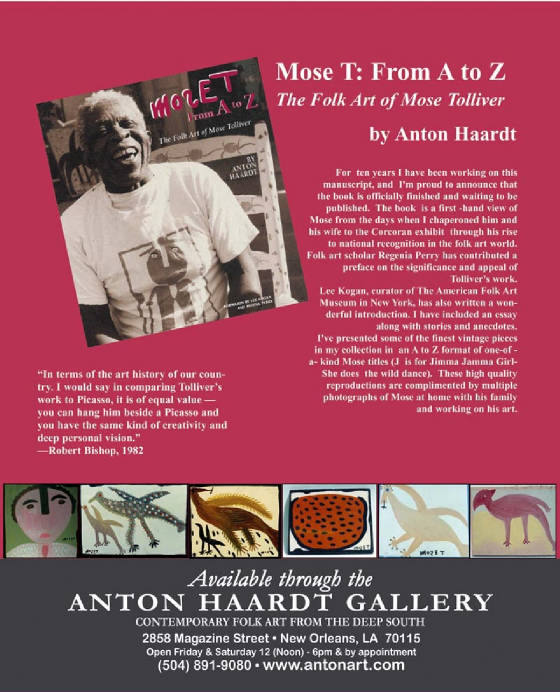
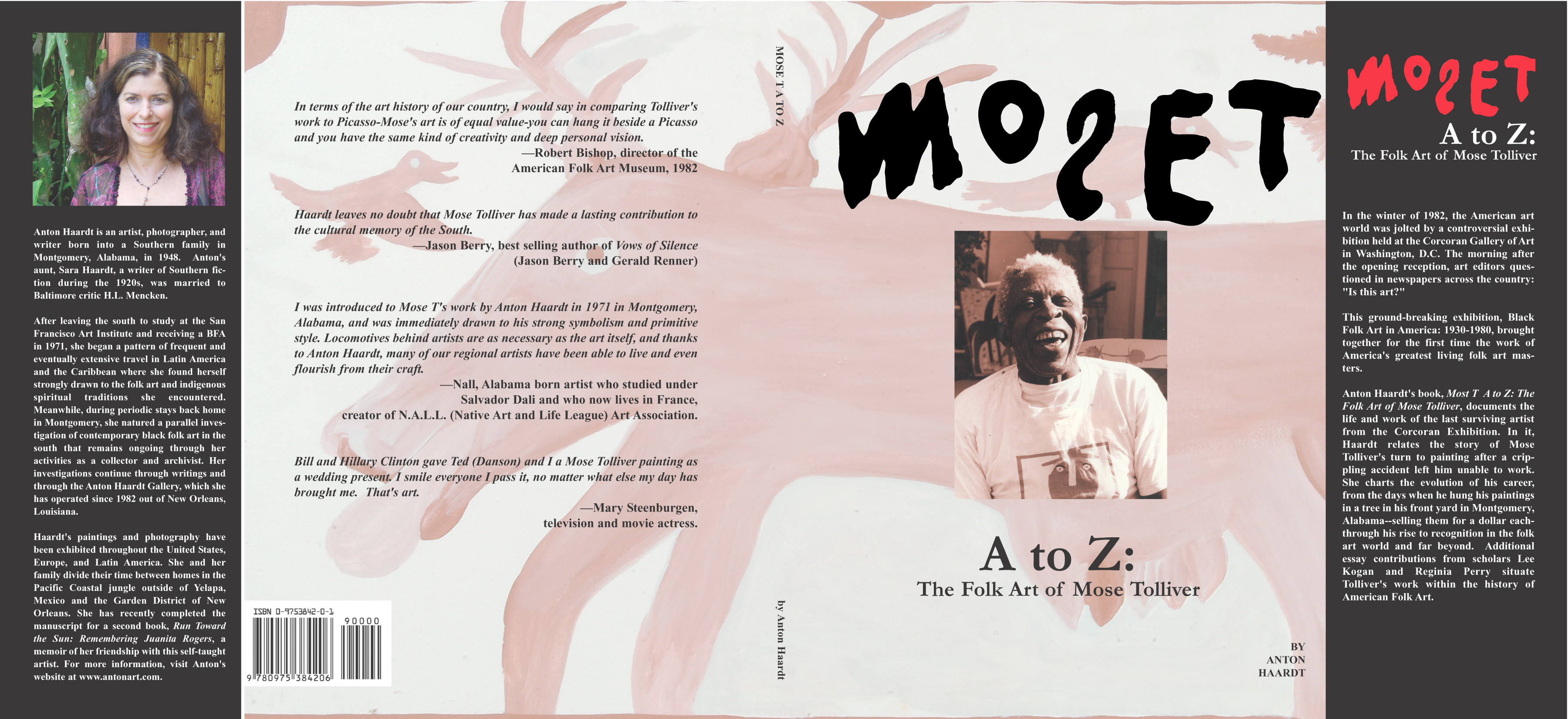
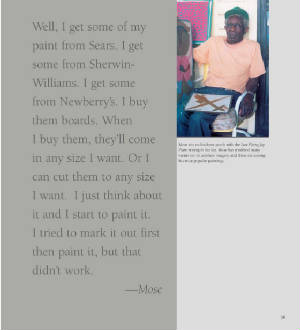
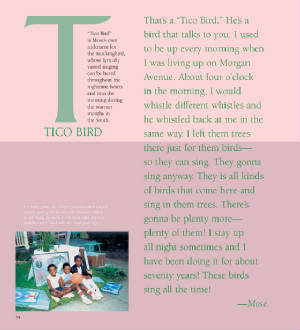
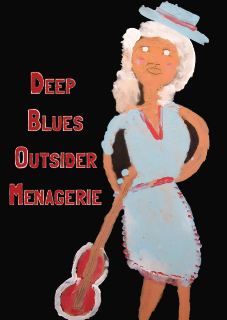
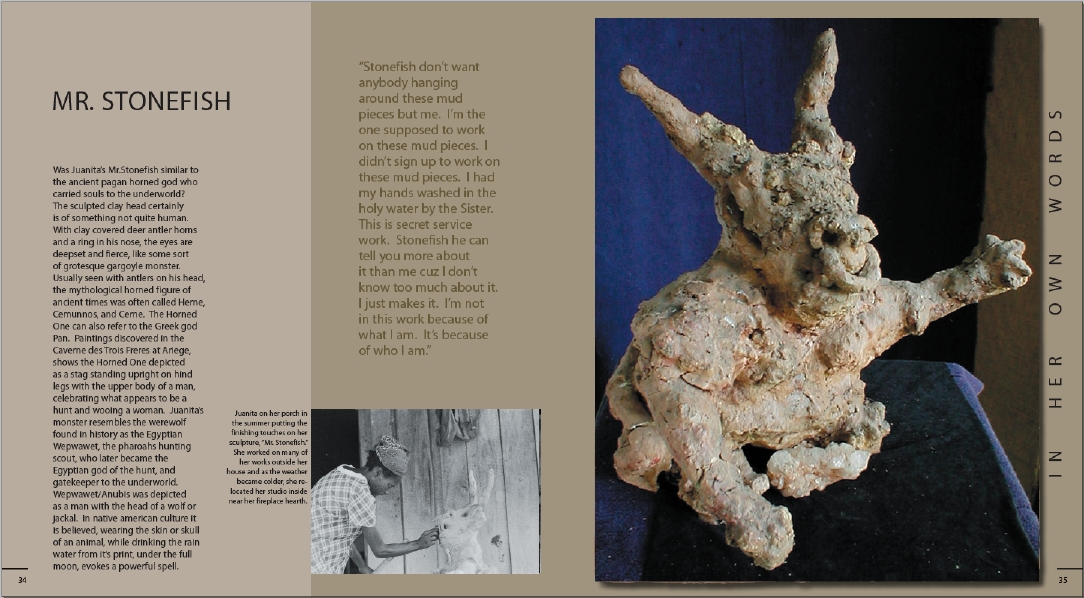
|
|